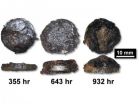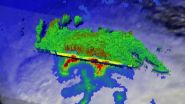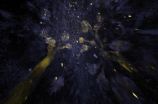(Press-News.org) New research from Northeastern University has mapped the intellectual migration network in North America and Europe over a 2,000-year span. The team of network scientists used the birth and death locations of more than 150,000 intellectuals to map their mobility patterns in order to identify the major cultural centers on the two continents over two millennia.
In the new paper, to be published Friday in the journal Science, the researchers found how locations such as Rome, London, and Paris have emerged as cultural hubs as more intellectuals died in these cities than elsewhere—regardless of where they were born. Additionally, the findings reveal that the distance between the birth and death locations of notable individuals has not increased much over the span of eight centuries—a remarkable showcase of human mobility patterns—despite the fact that colonization and transportation improvements have increased long-distance travel.
"By tracking the migration of notable individuals for over two millennia, we could for the first time explore the boom and bust of the cultural centers of the world," said Albert-László Barabási, Robert Gray Dodge Professor of Network Science and director of Northeastern's Center for Complex Network Research. "The observed rapid changes offer a fascinating view of the transience of intellectual supremacy."
In their paper, Maximilian Schich, the lead author and former visiting research scientist in the center, Barabási, and their co-authors presented a variety of new findings. For example, despite the arts' dependence on money, the cultural hubs that attracted the most intellectuals were not necessarily economic hubs.
In addition, they found that by the 16th century, Europe appeared to be characterized by two radically different cultural regimes: a "winner-takes-all" regime with countries where an individual city attracts a substantial and constant flow of intellectuals (i.e.: Paris, France) and a "fit-gets-richer" regime with cities within a federal region (i.e.: Germany) competing with each other for their share of intellectuals, only being able to attract a fraction of that population in any given century.
The team also found that there is no such thing as an average cultural center or average attractiveness consistent among locations. In fact, they scale and fluctuate heavily over time due to a variety of factors.
For example, while intellectuals have always flocked to New York City in great numbers, it was an even bigger source of talent in the 1920s, being the birthplace of a significant portion of individuals in the data set.
Additionally, locations like Hollywood, the Alps, and the French Riviera, which have not produced a large number of notable figures, have become, at different points in history, major destinations for intellectuals, perhaps initially emerging for reasons such as the location's beauty or climate.
The research has not only uncovered fascinating aspects of intellectual migration over two millennia, it also broke new ground in terms of its data-driven approach to understanding cultural history. The team used data going back several centuries to quantify qualitative knowledge and consulted vast amounts of literature.
They relied on large data sets, including the curated General Artist Lexicon that consists exclusively of artists and includes more than 150,000 names and Freebase with roughly 120,000 individuals, 2,200 of whom are artists. Through this novel approach, they identified a clear set of geographical patterns that would not be recognized using traditional quantitative historical methods. The third data set, the Getty Union List of Artist Names, was used to validate the results of the other two.
"We're starting out to do something which is called cultural science where we're in a very similar trajectory as systems biology for example," said Schich, now an associate professor in arts and technology at the University of Texas at Dallas. "As data sets about birth and death locations grow, the approach will be able to reveal an even more complete picture of history. In the next five to 10 years, we'll have considerably larger amounts of data and then we can do more and better, address more questions."
INFORMATION:
In addition to Schich and Barabási, the research team includes Dirk Helbing, chair of Sociology, Modeling, and Simulation at ETH Zurich in Switzerland; Chaoming Song; Yong-Yeol Ahn; Mauro Martino; and Alexander Mirsky —several of whom worked on this project while still at Northeastern.
Groundbreaking research maps cultural history
2014-07-31
ELSE PRESS RELEASES FROM THIS DATE:
NIST corrosion lab tests suggest need for underground gas tank retrofits
2014-07-31
A hidden hazard lurks beneath many of the roughly 156,000 gas stations across the United States.
The hazard is corrosion in parts of underground gas storage tanks—corrosion that could result in failures, leaks and contamination of groundwater, a source of drinking water. In recent years, field inspectors in nine states have reported many rapidly corroding gas storage tank components such as sump pumps. These incidents are generally associated with use of gasoline-ethanol blends and the presence of bacteria, Acetobacter aceti, which convert ethanol to acetic acid, a component ...
New bipartisan House bill draws on U-M health research
2014-07-31
ANN ARBOR—A new bill introduced in Congress with bipartisan support would allow Medicare to test a concept born from University of Michigan research, which could improve the health of patients with chronic illness while reducing what they spend on the medicines and tests they need most.
The bill, introduced last week by U.S. Reps. Diane Black and Earl Blumenauer, grew out of a decade of work by health policy researchers affiliated with the U-M's Institute for Healthcare Policy and Innovation. It would allow Medicare Advantage plans to use innovative "value-based" insurance ...
Parenting skills improve in ADHD parents with medication
2014-07-31
Parenting skills of adults with ADHD improve when their ADHD is treated with medication, according to Penn State College of Medicine researchers.
At least 25 percent of clinic-referred children with attention deficit/hyperactivity disorder have a parent with ADHD.
"Parents with ADHD are at increased risk to engage in problematic parenting techniques, including inconsistent disciplinary practices, making ineffectual commands and diminished use of praise," said James Waxmonsky, associate professor of psychiatry. "Having a parent with ADHD also decreases the chances that ...
The 'memory' of starvation is in your genes
2014-07-31
During the winter of 1944, the Nazis blocked food supplies to the western Netherlands, creating a period of widespread famine and devastation. The impact of starvation on expectant mothers produced one of the first known epigenetic "experiments" — changes resulting from external rather than genetic influences — which suggested that the body's physiological responses to hardship could be inherited. The underlying mechanism, however, remained a mystery.
In a paper published recently in the journal Cell, Dr. Oded Rechavi, Dr. Leah Houri-Ze'ev and Dr. Sarit Anava of Tel ...
NASA sees Tropical Storm Halong move northwest of Guam
2014-07-31
NASA's Tropical Rainfall Measuring Mission or TRMM Satellite passed over Guam as heavy rain fell over the island while Tropical Storm Halong's center passed just to the north of the island.
The TRMM satellite flew above tropical storm Halong on July 31, 2014 at 0904 UTC (August 1, 2014 at 7:04 p.m. local time, Guam).
At NASA's Goddard Space Flight Center in Greenbelt, Maryland TRMM data was used to create a rainfall analysis. The analysis derived TRMM's Microwave Imager (TMI) and Precipitation Radar (PR) data was overlaid on a visible/infrared image from Japan's MTSAT-2 ...
Asteroid attacks significantly altered ancient Earth
2014-07-31
TEMPE, Ariz. – New research shows that more than four billion years ago, the surface of Earth was heavily reprocessed – or mixed, buried and melted – as a result of giant asteroid impacts. A new terrestrial bombardment model based on existing lunar and terrestrial data sheds light on the role asteroid bombardments played in the geological evolution of the uppermost layers of the Hadean Earth (approximately 4 to 4.5 billion years ago).
An international team of researchers published their findings in the July 31, 2014 issue of Nature.
"When we look at the present day, ...
Mosaicism: Study clarifies parents as source of new disease mutations
2014-07-31
HOUSTON – (July 31, 2014) – Scientists have long speculated that mosaicism – a biological phenomenon, in which cells within the same person have a different genetic makeup – plays a bigger role in the transmission of rare disease mutations than is currently known. A study conducted by an international team of scientists led by Baylor College of Medicine sheds new light on the frequency of mosaicism in genomic disorders and its influence on recurrence risk.
The study, which was published today in the American Journal of Human Genetics, also included scientists from the ...
In high-stakes soccer, goalkeepers exhibit 'gambler's fallacy'
2014-07-31
When goalkeepers are pitted against multiple kickers in tense penalty shootouts, their attempts to dive for the ball show a predictable pattern that kickers would do well to exploit. After kickers repeatedly kick in one direction, goalkeepers become increasingly likely to dive in the opposite direction, according to an analysis of all 361 kicks from the 37 penalty shootouts that occurred in World Cup and UEFA Euro Cup matches over a 36-year period.
The findings reported in the Cell Press journal Current Biology on July 31 highlight the importance of monitoring and predicting ...
Selective logging takes its toll on mammals, amphibians
2014-07-31
The selective logging of trees in otherwise intact tropical forests can take a serious toll on the number of animal species living there. Mammals and amphibians are particularly sensitive to the effects of high-intensity logging, according to researchers in the Cell Press journal Current Biology on July 31 who conducted a meta-analysis of almost 50 previously published studies from around the world.
"Selective logging in the tropics is not a new phenomenon, and it will continue to be a common use of the forest," says Zuzana Burivalova of ETH Zurich, Switzerland. "We hope ...
See-through organs and bodies will accelerate biomedical discoveries
2014-07-31
The ability to see through organs and even the entire body to visualize long-range connections between cells as well as fine-grained cellular structures has been a long-time dream of biologists. A study published by Cell Press July 31st in the journal Cell has now made that dream a reality, revealing simple methods for making opaque organs, bodies, and human tissue biopsies transparent, while keeping the cellular structures and connections intact. The protocols could pave the way for a better understanding of brain-body interactions, more accurate clinical diagnoses and ...





